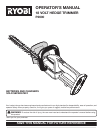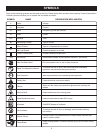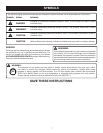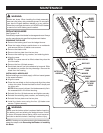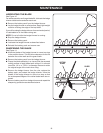
4 5
n Before starting the hedge trimmer, make sure the
blade is not in contact with any object.
n Stop the unit, remove the battery pack, and make sure
the blade has stopped before setting the unit down.
n Never cut any material with a diameter larger than
3/8 in.
n DANGER: Risk of cut. Keep hands away from blades.
Do not attempt to remove cut material or hold material
to be cut when blades are moving. Keep both hands on
handles when power is on. Make sure battery pack is
removed and the trigger is released when clearing jammed
material from blades. Do not grasp the exposed cutting
blades or cutting edges when picking up or holding the
unit.
n Blades coast after unit is turned off.
n Always stop the motor when cutting is delayed or
when walking from one cutting location to another.
n Keep unit clean of grass clippings and other materials.
They may become lodged in the cutting blades.
n Store the unit inside in a dry place, either locked up or
up high to prevent unauthorized use or damage. Keep
out of the reach of children or untrained individuals.
n Replace blade cover when unit is not in use.
n Never douse or squirt the unit with water or any other
liquid. Keep handles dry, clean, and free from debris.
Clean after each use; see Storage instructions.
n Secure the unit while transporting.
BATTERY SAFETY
n Battery operated units do not have to be plugged
into an electrical outlet; therefore, they are always in
operating condition. Be aware of possible hazards even
when unit is not operating.
n Remove the battery pack before making any
adjustments, cleaning, storing, or removing material
from the unit, or when not in use.
n A battery pack must be recharged only with the
specified charger for the battery pack. A charger that
may be suitable for one type of battery pack may create
a risk of fire when used with another battery pack. Use
battery pack only with charger listed.
MODEL BATTERY PACK (P100) CHARGER (P110)
P2600 130255004 1423701, 140237023
or 130224028 or 140237021
n To reduce the risk of explosion and possible injury,
DO NOT place battery units or their batteries near fire or
heat.
n Do not mutilate the battery pack. Released electrolyte
is corrosive and may cause damage to the eyes or skin.
It may be toxic if swallowed.
n Batteries vent hydrogen gas and can explode in the
presence of a source of ignition, such as a pilot light.
To reduce the risk of serious personal injury, never use
any cordless product in the presence of open flame. An
exploded battery pack can propel debris and chemical.
If exposed, flush with water immediately.
n Do not charge unit in a damp or wet location. Following
this rule will reduce the risk of electric shock.
n For best results, your battery unit should be charged
in a location where the temperature is more than 50°F
(10°C) but less than 100°F (38°C). Do not store outside
or in vehicles.
n Under extreme usage or temperature conditions,
battery pack leakage may occur. If liquid comes in
contact with your skin, wash immediately with soap and
water, then neutralize with lemon juice or vinegar. If liquid
gets into your eyes, flush them with clean water for at least
10 minutes, then seek immediate medical attention.
n A damaged battery pack is subject to explosion.
To avoid serious personal injury, properly dispose of a
damaged battery pack.
n Do not dispose of batteries in a fire. The cell may
explode. Batteries should be recycled. Consult your
local waste authority for information regarding available
recycling and/or disposal options.
n When battery pack is not in use, keep it away from
other metal objects like: paper clips, coins, keys, nails,
screws, or other small metal objects that can make
a connection from one terminal to another. Shorting
the battery pack terminals together may cause sparks,
burns, or a fire.
SPECIFIC SAFETY RULES



